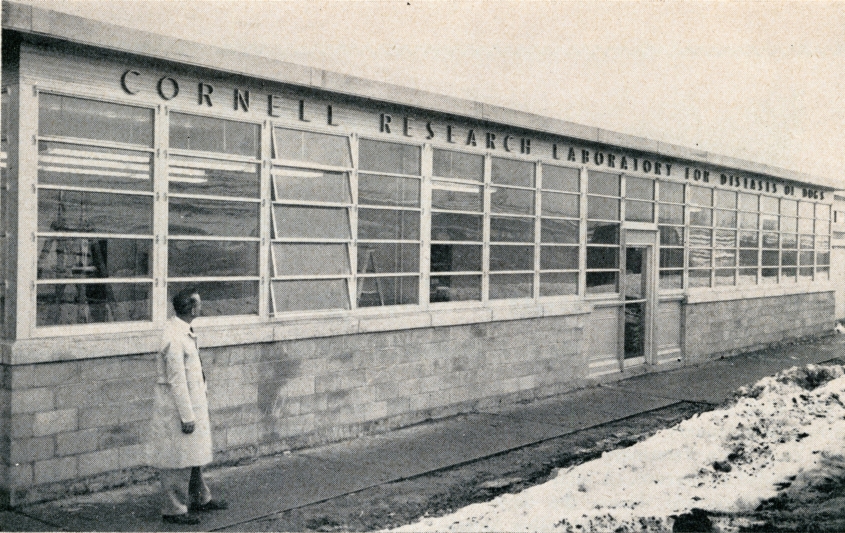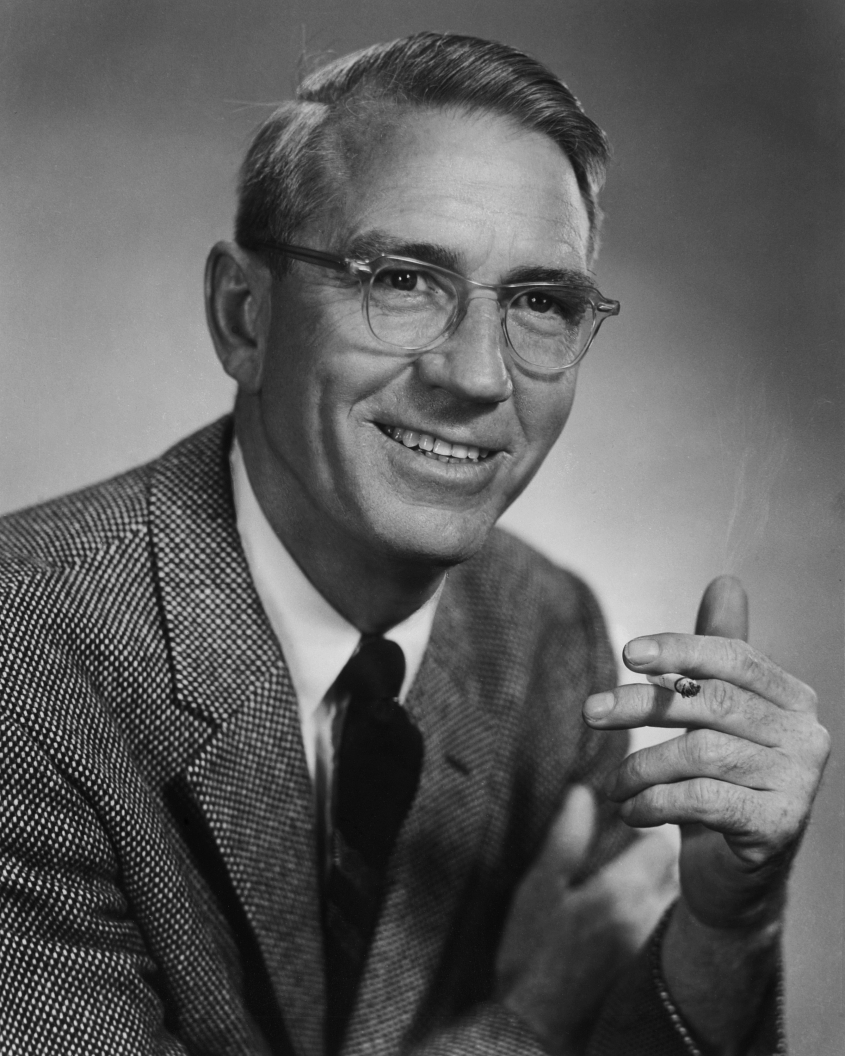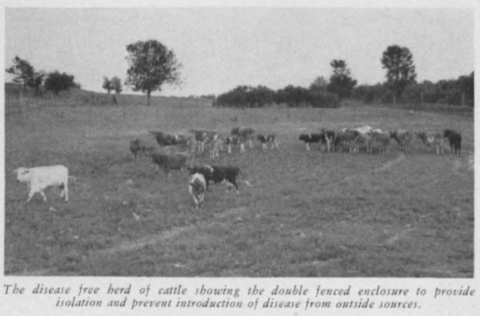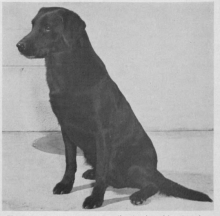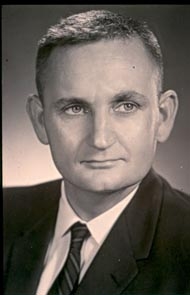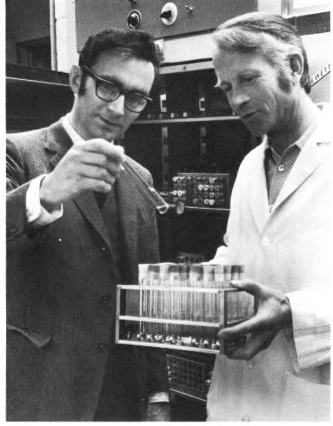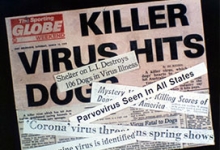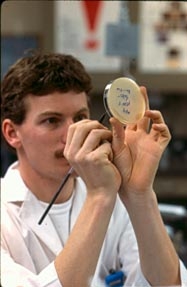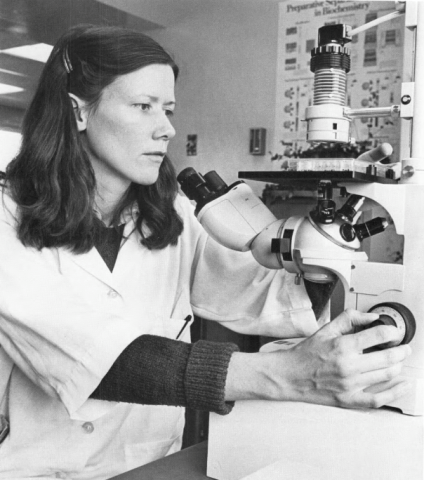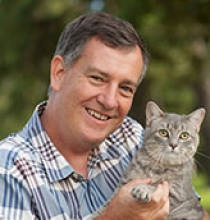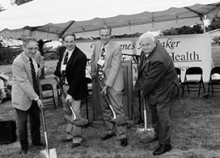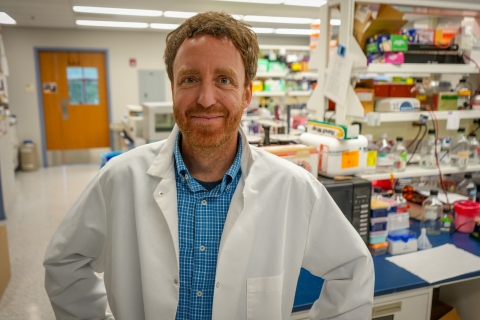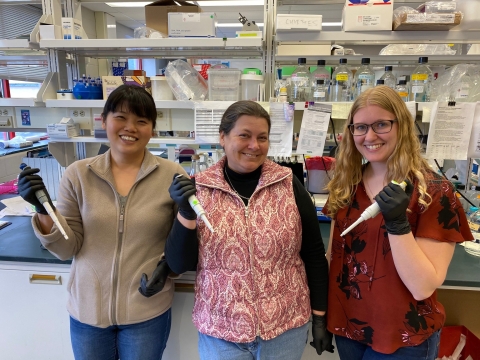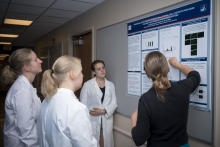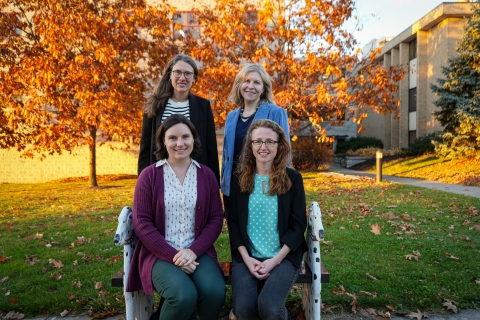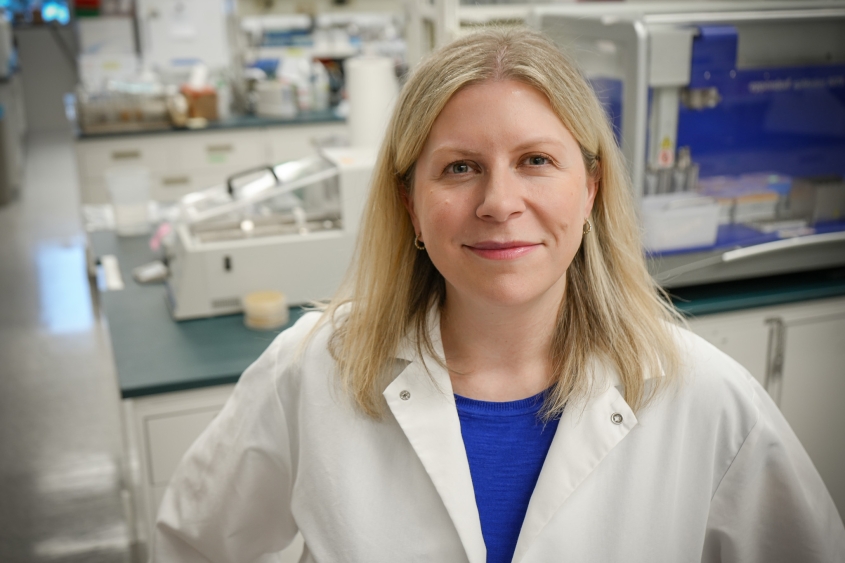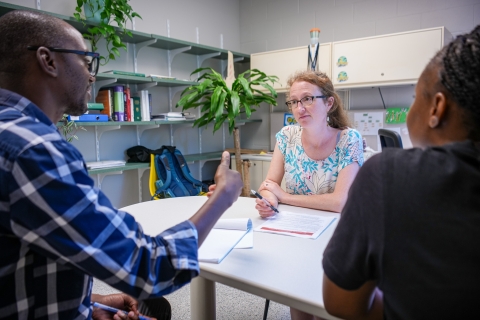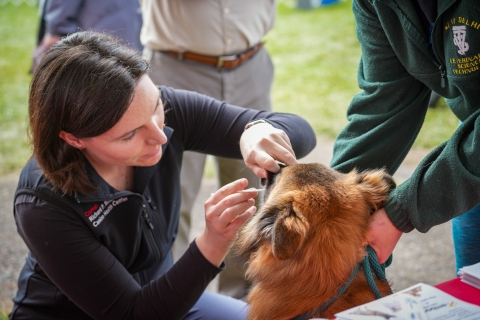75 Years of Discoveries
Behind the Scenes and on the Front Lines:
75 Years of Animal Health Discoveries at the Baker Institute
The Baker Institute has evolved and grown since its founding 75 years ago on a hill overlooking Cornell University, when it was surrounded by mud from its construction. The Veterinary Virus Research Institute, as it was called at the time, was formed to address viral diseases in a menagerie of species, including cats, pigs, trout, and cattle. Over the ensuing decades, although research on livestock declined, an equine program was established, and the Institute’s breakthroughs in the prevention and control of canine infectious diseases established the Institute as a global center for animal health research, including groundbreaking work in immunology, genetics, and cancer.
Over the 75 years the faculty grew in size, and the Institute underwent multiple expansions and renovations to accommodate new avenues of research.
What has not changed is the faculty’s commitment to improving animal health. Through both basic veterinary and biomedical research that underlies our deepest understanding of biology, and applied work that bridges the gulf between laboratory results and new therapies, Baker Institute scientists have continued to tackle challenging problems and emerging diseases.
“The Institute has evolved but it has not lost its compass,” said former director Dr. Douglas Antczak, Dorothy Havemeyer McConville Professor of Equine Medicine. “There has been continual necessary change that has kept the work at the Institute cutting edge, forged by the faculty and their passions for different aspects of veterinary medicine and animal health.”
Baker’s Beginnings
Dr. James Andrew Baker, known as Drew to his friends, was the driving force and founding Director of the Institute. The Cornell University Board of Trustees voted to establish the Institute on September 20, 1950, and the Cornell Research Laboratory for Diseases of Dogs was dedicated on January 5, 1951 as a division of the Institute. Dr. Baker had joined the faculty at Cornell in 1947, moving from the Rockefeller Institute, a prominent medical research center in New York City.
During the Second World War he had worked on livestock viruses, including rinderpest, a now extinct relative of measles that was incredibly deadly for cattle. At the new Veterinary Virus Research Institute, he developed vaccines to protect pigs against hog cholera—now known as swine fever—and various diseases of cattle.
The Institute was the perfect place for disease research—close enough to be affiliated with Cornell, but sufficiently isolated on Hungerford Hill (off of Snyder Hill) for faculty to work safely with infectious organisms. Dr. Baker set up laboratories and facilities for rearing disease-free animals, including a herd of cattle from the Rockefeller Institute that had no exposure to known viruses or some disease-causing bacteria, so they were perfect subjects for studying pathogens.
Dr. Baker was not only an excellent scientist; he also had a genius for fundraising and recruited prominent philanthropists to support the Institute. Robert Woodruff, the president of the Coca-Cola Company was a co-founder. In the early years, Baker received support and guidance from John M. Olin, a Cornell alumnus and vice president of the Winchester Repeating Arms Company and Chairman of the board of the Olin Corporation.
John Olin was an avid duck hunter with kennels full of hunting dogs that Dr. Baker had vaccinated against infectious hepatitis virus, now called canine adenovirus. Olin helped recruit fellow hunting enthusiasts to support the Institute’s work in dogs. Nancy Sayles Day and Colonel Lee Garnett Day, an executive of General Foods and Mrs. Rowena Teagle, the wife of the president of Standard Oil, were important early patrons. Geraldine Rockefeller Dodge, a Standard Oil heiress and avid dog enthusiast, donated funds to build the first ever tissue culture facility for veterinary research, so the institute’s scientists could study diseases in cell cultures instead of live dogs.
The Cornell Research Laboratory for Diseases of Dogs was the first permanent unit established for conducting research on dog diseases to be funded by private donations. Hundreds of dog owners, veterinarians, kennel clubs, hunt clubs, philanthropists and companies fill the donor list of the 1951 annual report.
One of the first disease targets was canine distemper—referred to as simply “the disease”— which commonly struck puppies, causing respiratory symptoms, vomiting, neurological problems and death. Two Institute scientists who later went on to distinguished careers in the Cornell Veterinary College made major discoveries about this disease. Dr. James Gillespie isolated the “Snyder Hill” strain of the distemper virus, which was used to develop a vaccine for the disease. Simultaneously, Dr. George Poppensiek (later Dean of the Veterinary College from 1959 to 1974) was developing the first vaccine for canine adenovirus, which caused especially severe symptoms in dogs that were already infected with distemper. The researchers also developed the first dual vaccine for dogs, which protected against both viruses. They reportedly tested the efficacy of the dual vaccine in John Olin’s hunting dogs before laying out guidelines for the nationwide vaccination program that occurred in 1960.
Research on distemper continued at the Institute all the way up to the 1990s, as canine distemper is still a threat to unvaccinated dogs, and is often severe in wild animals. For two decades, Dr. Max Appel’s lab produced distemper vaccines for zoos. In the 1990s, he identified a strain of distemper that was killing lions on the Serengeti Plain in East Africa and helped protect endangered black-footed ferrets from lethal infection with canine distemper virus which threatened to drive them to extinction.
One of Baker’s first graduate students was Dr. Leland “Skip” Carmichael who was appointed to the John M. Olin Professorship in 1963, just four years after completing his Ph.D. Early in his 41- year career at the Institute, Carmichael discovered the bacterium Brucella canis and developed a diagnostic test for the organism which was widely applied by breeders in the control of the abortion that is caused by Brucella. Dr. Carmichael also discovered and isolated canine herpesvirus, which can affect puppies and also cause reproductive disease in adult dogs.
Additional research from the early days focused on the bacterium responsible for kennel cough and the development of vaccines for leptospirosis, a bacterial infection of dogs and other animals transmitted through soil and water.
In the 1960s, John Olin urged the Institute to begin an “all-out campaign” to solve a scourge of hunting dogs—hip dysplasia. Biochemist Dr. George Lust was recruited to the faculty and spent decades researching the genetic and environmental factors that contribute to this degenerative condition. Richard King Mellon, the heir to the Mellon fortune, was also a great supporter of this research.
Changes and New Challenges
On April 14, 1975, Baker died suddenly, just months before the institute’s 25th Anniversary. That year the Board of Trustees of Cornell University honored him by renaming the Institute the James A. Baker Institute for Animal Health.
A year later, Dr. Douglas McGregor assumed leadership of the Institute. Dr. McGregor was a medical doctor who had most recently been working at the Trudeau Institute in Saranac Lake, NY, a former tuberculosis sanatorium and renowned biomedical research center. He had built up a large and active lab studying the role of white blood cells called lymphocytes in developing immunity and was excited to expand his lab and join the immunology research already underway at the institute.
With Dr. McGregor’s leadership came a shift in how the institute funded its research. According to Dr. Max Appel, Baker had a “You give me results and I will give you the money” strategy for distributing the results of his fundraising. But Dr. McGregor realized that external research funding, primarily in the form of large, project-sustaining awards from the National Institutes of Health, was a more sustainable approach. As the faculty began securing external grants, Dr. McGregor continued to fundraise, building up the endowment. NIH funding enabled researchers to tackle biomedical problems that afflicted both humans and animals, while donations allowed them to confront new threats and to conduct veterinary research that was harder to support through external funding. This model continues to remain how the Institute operates today.
“I think we were very lucky having recruited a scientist of Doug’s (Dr. McGregor’s) caliber to lead the Institute at a critical point in its history,” said Dr. Roy Pollock, chief learning officer of the 6Ds Company, and a former graduate student who worked with Dr. Carmichael. “He challenged the Institute to elevate its science to the next level.”
In 1978, when a mysterious disease that caused vomiting, severe diarrhea and death spread in dogs worldwide, Drs. Carmichael, Pollack and Appel were quick to respond. Dr. Appel first identified the canine parvovirus in the summer of 1978. With nowhere else to turn, veterinarians and pet owners from all fifty states began calling the Baker Institute and sending fecal samples for testing.
“I hated getting my mail,” said Pollock. That summer the lab fielded more than 10,000 phone calls and letters about parvovirus.
In the next three years, Drs. Appel, Carmichael and Pollock determined that parvovirus was a never-before-seen virus, developed a diagnostic test and created a vaccine by growing a less virulent form of the virus in cell cultures. The Institute’s isolation, disease-free dog kennels, tissue culture facility, faculty expertise and donor support, all made it the ideal place to tackle the disease. “That was a unique combination that allowed the Institute to make far more progress on this problem than anybody else. It was a very exciting, confusing and fascinating time,” said Pollock.
The researchers licensed their vaccine strain to companies to produce a parvovirus vaccine that has since saved millions of dogs from this devastating disease. For many years, the parvovirus vaccine was also the largest source of patent income for Cornell University.
“Every dog in the U.S. now is vaccinated against distemper, adenovirus and parvovirus. The institute faculty were involved in the development each of those vaccines,” said Colin Parrish, John M. Olin Professor Virology. “The reason we don’t talk about distemper or adenovirus anymore is because they’ve basically been controlled and eradicated by the vaccine. Although the parvovirus is largely controlled in dogs by the excellent vaccines available, some cases of severe or even lethal disease in puppies still occur due to the difficulty of ensuring that all puppies are vaccinated and protected before they encounter the viruses that circulate in nature.”
Colin Parrish completed his graduate work on parvovirus in Dr. Carmichael’s lab and “we’ve been studying the virus since then,” he said. He spent time in Australia as a post-doctoral researcher, then returned to the institute as a faculty member in 1988 and a year later identified the mutation that – before 1978 - had allowed a cat virus called feline panleukopenia virus to transform into canine parvovirus, triggering the pandemic.
His lab continues to drill down into the structure and evolution of parvovirus, which enabled it to jump from cats to dogs with devastating results. Along with serving as Baker’s director from 2010 to 2016, Dr. Parrish has remained on the forefront of emerging viruses, and his laboratory has also studied the H3N8 and H3N2 canine influenza outbreaks that occurred after 2000 and 2015, respectively.
The Growth of Molecular Biology
Throughout the 1980s and 1990s, the institute added faculty members and made improvements to the facilities and equipment. “The lab has a tradition of keeping up with technology,” said Dr. Judith Appleton, Alfred H. Caspary Professor Emeritus of Immunology. Appleton joined the institute as a postdoctoral researcher in Dr. McGregor’s group in
1982 to investigate how the immune system responds to trichinosis and other parasites that invade the body through the intestine, and stayed on as a faculty member. She retired in 2019 after serving as a Vice Provost for Cornell University for six years.
Dr. Appleton emphasizes, however, that “one of the most important products of the institute is the trainees who go on to other places.” Numerous trainees, from high school students to postdoctoral researchers, have come through Baker’s labs. Seven former trainees have been appointed deans of veterinary colleges and one is a university president.
Many students in DVM programs have participated in the Cornell Leadership Program for Veterinary Students, started by McGregor in 1989 to cultivate new generations of veterinary scientists. The program provides veterinary students with mentoring and a summer research experience. Since its inception, over 690 students have participated, and about one third have attained Ph.D. s, and many have gone on to research careers in veterinary and other health research. The program was directed by Dr. John Parker for many years and is now part of the newly combined program called the Veterinary Investigation and Leadership Program (VILP).
In 1994, Antczak became the new director and during his 15 years at the helm, built two new wings and renovated many of the older lab spaces. The growth of the Institute also mirrors the huge expansion of molecular biology research that has occurred during the same era. Scientists at the institute made rapid-fire discoveries identifying the cause of genetic diseases affecting reproduction, the skeletal system and vision.
In his own work, Dr. Antczak has studied equine genetics and immunology. In one study he has bred horses with a very narrow gene pool to understand the role of a set of immune genes in responding to disease and also revealing how a pregnant mother is able to tolerate the developing fetus within its body.
A member of this herd named Twilight was the first horse to have its genome sequenced as part of the Horse Genome Project that began in 1995. The sequence, completed in 2006 has revolutionized all aspects of equine research. Among other accomplishments, Dr. Antczak’s lab also developed a genetic test to prevent the breeding of horses with Lavender Foal Syndrome, a deadly genetic condition in Arabian horses.
In dogs, Drs. Gregory Acland and Gustavo Aguirre contributed to mapping the dog genome and made tremendous strides identifying and locating genes related to canine eye diseases and blindness. This work led to genetic tests for night blindness in Briard dogs, a malformation called retinal dysplasia in Labrador retrievers and Samoyeds, and a condition called Collie eye anomaly. With colleagues, they also developed a gene therapy technique to reverse blindness—the first gene therapy applied in a large animal. In 2017, the Food and Drug Administration approved a gene therapy to treat a rare form of human blindness based on Drs. Acland and Aguirre’s work in dogs.
“There are children today who are no longer legally blind, having been treated successfully with the same gene therapy eye treatment that Gus developed in dogs,” said Dr. Antczak.
Looking Forward
In the Institute’s recent history, faculty have continued to make foundational discoveries and develop new technologies that will no doubt advance their field. For example, Dr. Alexander Travis is developing new reproductive technologies that resulted in the first puppies born by in vitro fertilization in 2015
And Dr. Charles Danko, Robert N. Noyce Assistant Professor in Life Science and Technology, is building novel computational tools to understand the processes by which different genes are turned on and off, and how that contributes to animal evolution, development and disease.
With the success of vaccines developed at the Baker Institute and elsewhere, most dogs no longer die from viruses or bacteria, but live long enough to suffer from diseases of aging, like cancer. Baker scientists are taking up the challenge to address these problems.
“One of the strengths of the institute is that it does very high-quality basic science to help define the mechanisms of disease—both infectious and non-infectious diseases—and understanding those mechanisms are going to lead to better diagnostics and better treatments,” said Dr. Keith Richter, a veterinary gastroenterologist and member of the Baker Institute and Animal Health Research and Outreach Committee.
Currently, labs at the Institute are investigating human breast cancer and mammary cancer in animals. Brooke Marks, a former graduate student working with former director Dr. Scott Coonrod, the Judy Wilpon Professor of Cancer Biology investigated why a common type of tumor called estrogen-receptor-positive (ER+) breast cancer becomes resistant to drugs that should keep it in check. About 70 percent of all breast cancer cases are ER+ and are routinely treated with drugs that block or degrade the estrogen receptors the tumors use to grow. However, up to 40 percent of those tumors will become resistant to the drugs and evolve new ways to proliferate. Marks used gene editing technology in breast cancer cell cultures to turn on genes one at a time and see which ones are involved in developing resistance to the drugs.
“Our goal is to look at other mechanisms or pathways that promote resistance,” said Marks. “If we can identify these pathways, hopefully we can help these patients either with combination therapies or an alternate therapy.” This work may also find biomarkers that can identify patients who are likely to develop resistance.
Dr. Gerlinde Van de Walle is taking a broader approach to mammary cancer by comparing cells from two types of mammals: those with high rates of the disease, like humans and dogs, and those that rarely develop mammary cancer, such as cows and horses. “Thanks to the wide variety of veterinary species and wild mammals we can examine, we can find clues as to why species differ in their likelihood of developing mammary cancer,” said Dr. Van de Walle. So far, she has identified differences between the two groups in molecules called microRNAs, which regulate which genes are turned on or off inside cells. If these same differences can be detected in women or animals with mammary cancer, the research could lead to a useful diagnostic test for breast or mammary cancer.
Dr. Van de Walle’s group also has identified defense mechanisms produced by cows and horses that may attack tumor cells as they arise. “Down the road, that could be a novel therapeutic,” said Van de Walle.
She received a grant from the Schwartz Research Fund for Women and other Underrepresented Faculty in the Life Sciences to explore these differences in more detail by transplanting mammary tissues from different species into mice.
“Mammalian species are so similar. Learning insight into one species is going to provide insight into other species as well,” said Coonrod. “Putting those different types of researchers together is how we’ve really made progress in the past, and how we will continue to advance the health of animals in the future.”
In 2020, as the world came to a halt due to the COVID-19 pandemic, The Baker Institute remained vigilant in its reputable fight against viruses. Dr. Luis Schang, professor of chemical virology who served as director of the Baker Institute from 2016 – 2019, along with a group of researchers from across the College of Veterinary Medicine came together to better understand the virus and to begin the work toward future treatment and containment.
Providing expert perspective on infectious disease, virus mutation, and vaccine discovery research, Baker faculty worked to both to educate the public during this time and toward protection from future outbreaks.
The Baker Institute remains committed to its mission of being the leading academic Institute advancing veterinary and human medicine worldwide and training the next generation of scientists. The faculty who have joined the Institute most recently – Drs. Sarah Caddy, Mandi de Mestre, Laura Goodman, and Jacqueline Evans, all have conducted some of their training here at the Baker Institute themselves. Since its founding in 1950 the Baker Institute has been preeminent in the training of graduate and postdoctoral students striving to be at the forefront of research transforming the future of veterinary and human medicine. Trainees have gone on to lead in fields of academic research, teaching, industry, and government service. And we are lucky that some have returned, to continue their career as dedicated and visionary researchers working together—learning and building upon each other’s successes—to achieve extraordinary results.
Together, these four faculty are perpetuating the strong legacy of veterinary research training here and they are forging interconnected pathways to discovery in key areas of priority to the Institute and its mission. Those include canine genetics related to inherited diseases and cancer, equine reproduction and physiology, optimizing protection against viruses – particularly for newborns, and studies of emerging pathogens in animals and humans.
Each have set up a vibrant and active research program that addresses global challenges. And while they are all traveling very different paths, they are working together in the collaborative space that the Institute perpetuates, to create a world of healthier animals and people.
Mandi de Mestre, BVSc (hons) Ph.D., PGCAP, MRCVS
In the Equine Pregnancy Laboratory (EPL), Dr. Mandi de Mestre, the Dorothy Havemeyer McConville Professor of Equine Medicine in the Department of Biomedical Sciences, and newly named director of the Baker Institute as of February 2025, de Mestre focuses her work on reproduction and fertility. Using the horse as a model to understand healthy pregnancies and the diseases that compromise them, she is a leading genetic research into why 10-15% of horses around the world lose established pregnancies each year.
“We're addressing the genetic characteristics that are needed for survival (of the equine fetus),” said de Mestre, who collaborates closely with veterinarians desperate to find the underlying causes of pregnancy loss. As a global leader in this research, the lab uses samples from around the world to study the genetic disruptions that lead to miscarriages in horses.
The EPL at the Baker Institute now receives samples from more than a half dozen states, as well as Argentina, Ireland, France, and Germany. The global reach, de Mestre says, helps them understand the larger picture of the underlying causes behind the genetic variants they found – whether it’s purely genetic errors or involves an interaction between genes and exposures in the horses’ environment. “It’s an incredibly common phenomenon that is found in horses around the world, but our data suggests the frequency differs. Through the study of these diverse populations and breeds, we hope to distinguish between underlying genetic causes of these chromosomal errors versus tangible environmental exposures that could ultimately be modified to reduce the impact of this devastating condition,” she said.
The horse also provides a unique model for human medicine, where doctors are working to understand the 23 million miscarriages suffered annually by women worldwide. Studying shared fundamental genetic mechanisms, equine and human researchers can benefit from each other’s’ knowledge. A former Baker trainee in the lab of Dr. Doug Antczak, de Mestre continues to strengthen those collaborations, and is soon to be working with human researchers, sharing data from her Baker Institute lab.
Laura Goodman, Ph.D.’07
Working at the intersection of human, animal, and environmental health, Dr. Laura Goodman, and the Goodman Pathogen Genomics Lab investigates antimicrobial resistance, which occurs when bacteria and viruses develop the ability to resist drugs and treatment. It’s a worldwide phenomenon that affects both animals and people.
“A lot of our work starts with surveillance and understanding what’s out there, and then we try to understand how pathogens adapt to different hosts,” said Goodman of her current global outreach. “What happens with animals and the environment is eventually going to affect us and we can affect animals as well.”
Using this One Health approach, the lab analyzes, among other things, domestic avian flu and canine flu samples and, most recently, international feline infectious peritonitis cases, working towards making all the data public for researchers worldwide. As part of Baker’s mission for training and education, Goodman, an assistant professor in the Department of Public & Ecosystem Health, who was a former Baker trainee in the lab of Dr. Colin Parrish, is now training others in emerging genetic technologies, and next planning a trip to a Kenyan laboratory in the near future.
True to the Baker Institute’s vision of a world of healthier animals, Goodman is very interested in understanding how antimicrobial resistance impacts companion animals. “Not only can they potentially give us infections, but they can suffer from resistant infections themselves,” she said as she looks to not only improve the fundamental understanding of how microbes replicate but keep an eye out for pathogens in animals that could eventually infect people.
Sarah Caddy, MA ,VetMB, Ph.D., DACVM, FRCVS
Rotavirus is the leading cause of infectious acute gastroenteritis around the world, hitting children under 5 particularly hard. And while a vaccine is 95% effective in protecting children in the United States, in low- and middle-income countries it struggles to protect half the children.
In her lab, assistant professor in the Department of Microbiology and Immunology Dr. Sarah Caddy and her team focus on anti-viral antibodies and have partnered globally to study the processes underlying this issue.
“Mothers in low- and middle-income countries are exposed to more infectious diseases, so their immune system is constantly making more antibodies,” explained Caddy, a former Baker trainee in the lab of Dr. John Parker. “Mothers pass down these antibodies to their children via the placenta and in breast milk, but these interfere with the rotavirus vaccine. This means the child isn't able to mount their own immune response to vaccination quite so well.”
Working with teams in Vietnam and Zambia, as well as the global vaccine non-profit organization PATH and the Gates Foundation, the Caddy lab receives serum samples from vaccinated children and screens them for antibodies. The data is returned to a large repository where comparison and analysis is done.
“It’s our hope that understanding how vaccine-induced antibodies are working will help design the next generation of vaccines. This has the potential to reduce child mortality in the longer term,” said Caddy, adding that the work will also benefit our pets. “Understanding more about this in humans will pave the way for exploring this in our dogs and cats.”
Jacquelyn Evans, Ph.D.
The Evans Lab, led by Dr. Jacquelyn Evans, puts our pets’ DNA under the microscope, focusing its research on canine disease genetics. By finding genetic markers, scientists can predict the possibility of a dog developing a given disease during its lifetime, and ultimately, genetic tests can help breeders produce healthier dogs.
She’s currently the primary investigator for a global gastric cancer study, collaborating with Utrecht University in the Netherlands and the University of California at Davis. Relatively rare in the greater canine population, it’s more common in the Belgian sheepdog and Belgian Tervuren breeds. Gastric cancer is also a complex disease with 15 genes involved, so Evans, an assistant professor in the Department of Biomedical Sciences, must cast a wide net.
“It takes a large population to find all those genetic components,” she said. Breed clubs are important partners, and the lab has harnessed the power of social media to reach breed enthusiasts worldwide. With both affected and healthy dogs needed to validate the science, they are collecting samples from hundreds of dogs.
Here is where man’s best friend really steps up. People, too, are affected by gastric cancer, but our genetic diversity makes it a lot harder to find the problem DNA.
“You would need tens of thousands of people,” said Evans of the sample size to pin down the gene mutations in humans. “But when we work within a dog breed, they are genetically very similar and key differences stand out. Almost all the diseases we work on have a direct human counterpart. We've found a lot of overlap with the genes that are important in the human disease process; we’ve even seen the exact same mutation occur in both dogs and humans.”
As Baker’s reputation for excellence and groundbreaking work grows, so, too, do its collaborations. Researchers, academic institutions, and global non-profits all regularly reach out to faculty for their insight and expertise. The Evans Lab is currently involved in four major studies and collaborating on three more and de Mestre is strengthening her partnerships with human medicine researchers. Through collaborative grants, the Caddy Lab has hosted rotavirus immunology researchers from Zambia and the Goodman lab works here at home with the federal Food and Drug Administration’s Center for Veterinary Medicine, sequencing isolates and making the data publicly available to researchers around the world.
Article by Patricia Waldron, further edits by Baker Institute for Animal Health



